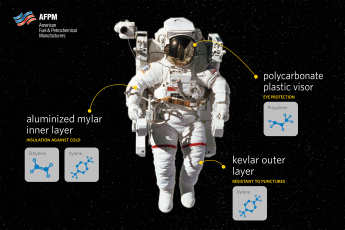What makes these products possible?
From the insides of computers, to the plastic exterior of smartphones, to the insulating coating on nearly every single wire of our electronic devices, petrochemical products are critical to enabling the innovation and disruptive technological advancements that make our world and lives better. During this week’s Consumer Electronics Show (CES) in Vegas, we’re taking a look behind the screens of some of the hottest products on the market to unveil what really makes them work, and why it’s important for policymakers to consider the impact of products derived from oil and natural gas on the advancement of our technology.
In the world of voice-activated assistants like Amazon Echo, Google Home and Apple’s up-and-coming HomePod, consumers have become quite comfortable with the convenience of remote commands to turn on their lights, turn down their thermostats, or read aloud the latest news headlines. Making these products affordable for the everyday consumer is equally important as competition in the space continues to grow, such as Roku’s plan to roll-out its own voice-activated capabilities to accompany its streaming players later this year.
Behind the sleek exteriors of these smart devices lies a web of wires coated with flexible plastic to dissipate the heat from electricity running through them, and protect the underlying copper wires from touching, which would cause a number of electrical shock issues otherwise. Other light-weight plastic components enable the devices to have separate compartments for the motherboard, microphone and sensors, as well as provide stability and shock-absorbent durability. The functionality of these devices is made possible by various types of plastics that can be rigid or flexible, depending on the needs of the device, all of which are derived from oil and natural gas.
Sony’s Aibo, a robotic dog that the company first unveiled in 1999, has undergone several upgrades since it first premiered and was reintroduced at this year’s CES after more than a decade-long hiatus. The popular robotic dog is praised for behaving like a real dog using artificial intelligence to learn and interact with its surroundings, and is now equipped with new sensing and movement technology. But to make the dog move in the life-like way it does requires a series of mechanical gears and friction-reducing lubricants, as well as lightweight plastic components, all of which come from oil and natural gas.
Resin adhesives, made from petrochemicals, are also used in robotics like the Roomba Robot Vacuum to bind mechanical parts together, reduce gear wear and noise, and give these robots the ability to move in unique ways. In fact, these same petroleum-based products are also critical to medical advancements in prosthetic limbs, such as the lightweight polypropylene used to make knee sockets that enable injured veterans to walk again.
From our vantage point as the voice of the petrochemical industry, it’s difficult to look at all the advanced electronic technology being showcased at this week’s CES without wondering where these products might be without the plastics that make them possible. Without the abundance of materials that come from oil and gas development, these devices might not be commercially or economically viable, and our world of convenience, comfort and control would probably look quite different.


